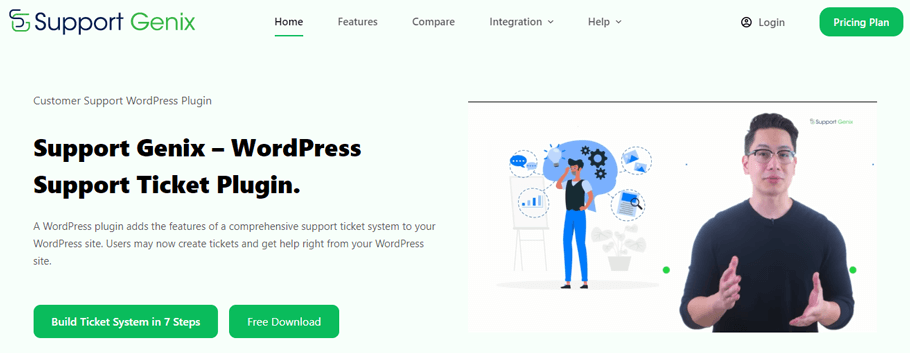Are you tired of dealing with dissatisfied customers who leave bad reviews and hurt your online business? Do you want to improve customer loyalty and increase sales on your eCommerce website? If the answer is yes, then you’re in the right place!
Customer service is crucial for running an eCommerce business. With the rise of online shopping, customers have come to expect fast and efficient support from businesses.
In today’s competitive market, providing exceptional customer service is key to standing out and building a loyal customer base. That’s why we have compiled a list of the top 10 eCommerce customer service best practices that will help elevate your brand and keep your customers returning for more.
Key Takeaways
- Selecting the right customer support software, such as a WordPress support ticket system, is essential for managing inquiries.
- Fast response times are essential, and aim to resolve inquiries within hours for customer satisfaction.
- The significance of offering multiple communication channels (e.g., social media, live chat) and quick responses to meet customer expectations.
- Gain insights into simplifying processes like returns and offering self-service options to reduce friction and enhance customer satisfaction.
- Regularly review and refine customer service strategies to maintain high standards and satisfaction.
What is eCommerce Customer Service?
eCommerce customer service encompasses the assistance and support provided to online customers. This involves addressing inquiries, resolving issues, and ensuring a seamless shopping experience. Effective eCommerce customer service is crucial for maintaining customer satisfaction, fostering loyalty, and driving business growth.
According to survey, 73% of consumers say good customer service can make them fall in love with a brand.
Why Customer Service is Important in eCommerce
Customer expectations are higher than ever. With countless options available at their fingertips, customers demand efficiency and quality. Exceptional eCommerce customer service can differentiate your business from competitors, enhance customer retention, and boost your bottom line.
Moreover, happy customers are more likely to become brand advocates, spreading positive word-of-mouth and attracting new customers.
The Strategic Role of Customer Service
Effective customer service is not just about resolving issues. It’s a strategic asset that elevates the customer experience, fosters long-term loyalty, and boosts profitability. Seamless and responsive service creates a memorable shopping experience, positioning your brand as one that values customer satisfaction.
Impact on Repeat Purchases and Customer Loyalty
The significance of customer service in eCommerce is underscored by compelling statistics:
- 89% of consumers are more likely to make repeat purchases after a positive customer service experience.
- In 2024, 90% of customers stated that their interactions with a brand’s customer service influenced their purchasing decisions.
These figures highlight customer service as a pivotal element in retaining customers and encouraging repeat business.
Enhancing Customer Experience
A great customer experience is critical in differentiating a brand in a crowded market. Customer service plays a crucial role by creating positive interactions at every touchpoint. Businesses are increasingly recognizing this, with 80% planning to boost investments in customer experience management.
By focusing on customer satisfaction and personalized interactions, brands can ensure a seamless shopping journey that meets and exceeds consumer expectations.
Reducing Costs and Driving Revenue
Good customer service can lead to significant cost savings and revenue growth.
- It is estimated that improving customer retention by just 5% can increase profits by up to 25%.
- Moreover, businesses prioritizing customer experience report nearly double the revenue growth compared to those not.
Satisfied customers are more likely to return and spend more, reducing the costs of acquiring new customers. Additionally, great customer service minimizes the need for costly returns and refunds, as issues are resolved proactively before they escalate.
Recommended Blogs for You:
👉 7 Best Google Analytics WooCommerce Plugins for Your Online Store
👉 14 Proven Ways to Optimize WooCommerce Product Pages
👉 8 Potential Tips for Creating Email Popups: Boost Your Email Marketing
👉 10+ Exit Intent Popup Examples to Increase Conversions
👉 10+ Exit Intent Popup Examples to Increase Conversions
Top 10 eCommerce Customer Service Best Practices
As an online business owner, providing exceptional customer service is crucial in today’s competitive market. With just a few clicks, customers can easily find alternative options if they are not satisfied with their experience. That’s why it is essential to prioritize customer satisfaction from start to finish.
We will explore the top strategies used by successful businesses to provide excellent eCommerce customer service.
1. Choosing the Right Customer Support Software
Selecting the right Commerce customer support software is crucial for efficient and seamless service. Look for platforms that integrate well with your eCommerce site, offer 24/7 customer service, and provide Omnichannel support across multiple communication channels, such as email and social media like WhatsApp.
Consider tools like Support Genix, which integrates with WooCommerce and other platforms, providing a unified solution to manage tickets efficiently.
2. Implement Fast Response Times:
Speed is of the essence in eCommerce customer service. Customers expect quick resolutions to their issues. Aim to respond to inquiries within a few hours, if not minutes. Utilizing automated responses for common queries can help manage expectations and keep response times short.
A survey of 3,200 consumers found that 46% expect companies to respond to emails within 4 hours, and 12% expect a reply in 15 minutes or less. Additionally, 90% of customers value instant responses, with 60% defining “instant” as within 10 minutes.
Amazon’s customer service is known for its rapid responses. It often resolves issues within minutes, which enhances customer trust and loyalty. Fast responses also help retain customers by addressing their concerns promptly.
3. Multiple Channels of Communication:
Offering multiple communication channels such as email, phone support, and social media ensures customers can reach you in their preferred way. A study by Microsoft found that 66% of consumers use at least three different communication channels to contact customer service.
Companies today must interact with customers across multiple channels, including social media, live chat, and offline options like in-store interactions. Customers expect consistent communication and support, whether they’re engaging with a service team via live chat software or through other platforms.
This approach is known as omnichannel support, where companies ensure seamless customer experiences across all touchpoints.
IKEA is an excellent example, excelling in omnichannel support by investing in more stores, home delivery, and a new app. This consistency has made them one of the world’s most beloved brands, with annual revenues exceeding $40 billion.
4. Going the Extra Mile to ‘Wow’ Customers
Exceeding customer expectations can create memorable experiences and foster loyalty. A study by American Express found that 70% of consumers are willing to spend more with companies that provide excellent customer service.
The outdoor retailer REI has a reputation for exceptional customer service, such as replacing a customer’s lost wedding ring during their hiking trip or sending care packages to customers stranded on delayed flights.
On the other hand, Ritz-Carlton is famous for empowering employees to spend up to $2,000 per guest to resolve issues and exceed expectations.
This approach leads to high customer satisfaction and word-of-mouth referrals. By going the extra mile, eCommerce businesses can turn occasional buyers into loyal advocates.
5. Focusing on Key Performance Indicators (KPIs) That Matter
Monitoring KPIs such as First Response Time, Customer Satisfaction Score (CSAT), first contact resolution rates, and Net Promoter Score (NPS) helps evaluate the effectiveness of customer service.
For example, tracking CSAT allows businesses to identify service areas needing improvement.
Shopify uses KPIs to continuously refine its customer support, resulting in consistently high customer satisfaction rates.
Amazon also tracks customer satisfaction ratings for each support interaction and uses this data to continuously improve its processes and training.
6. Simplify the Returns Process:
A complicated or awkward returns process can lead to customer frustration and dissatisfaction. A study by Invesp found that 92% of customers will buy again if returns are easy.
For example, Zappos offers a 365-day return policy with free shipping, simplifying the process for customers and encouraging repeat business. Simplified returns can reduce friction and enhance trust.
Online fashion retailer ASOS offers a streamlined and convenient returns process. Customers can easily print return labels and drop off packages at designated locations.
7. Making Self-Service a Priority
Empowering customers with self-service options can reduce the burden on your support team and provide an instant solution for simple inquiries. Many businesses integrate helpdesk software with comprehensive knowledge bases and FAQ sections, allowing customers to find answers independently.
A study by Microsoft found that 90% of customers expect a brand to offer self-service options.
Empower customers to find answers independently by creating a comprehensive knowledge base, FAQs, and video tutorials. This could include using customer feedback forms to allow customers to voice their concerns and questions directly.
8. Collect and Utilize Customer Feedback:
Gather feedback regularly through surveys, reviews, and direct interactions. Use this information to identify pain points and areas for enhancement. Listening to your customers and acting on their feedback demonstrates that you value their opinions.
A study by American Express found that 68% of customers will stop doing business with a company if they feel their feedback is not valued.
The online marketplace Etsy uses customer feedback to make data-driven improvements, resulting in increased seller satisfaction and overall customer loyalty. Additionally, utilizing customer reviews can provide valuable insights into areas for improvement.
9. Continuous Training for Support Teams:
Ongoing training ensures that your support team is equipped with the latest skills and knowledge. Regular workshops and scenario-based training, integrated with a WordPress support ticket system, can help your team stay updated.
Ongoing training ensures support teams are knowledgeable and equipped to handle various scenarios. According to LinkedIn, companies that invest in employee training see a 24% higher profit margin.
For instance, eCommerce giants like Apple provide extensive training programs to their support staff, ensuring they deliver top-notch service.
10. Continuous Improvement
Customer service is an evolving field. Stay updated with industry trends, technological advancements, and customer expectations. Regularly review and refine your processes to ensure you’re always delivering top-notch service.
Data analytics can lead to significant improvements. Using customer journey mapping, companies can identify pain points and optimize the customer experience. This leads to higher satisfaction and loyalty.
Regularly assessing and refining customer service strategies is essential for maintaining high standards.
Benefits of Providing Good Customer Service in eCommerce
Good customer service in eCommerce benefits customers by improving their overall experience, increasing satisfaction, and fostering loyalty. These benefits, in turn, drive business success through higher sales, reduced return rates, and a stronger competitive position.
- Increased Customer Loyalty
Prompt and personalized support makes customers feel valued and encourages them to return for future purchases. A positive experience, such as quickly resolving a shipping issue or offering easy return and refund policies, builds lasting trust. - Positive Word-of-Mouth and Reviews
Satisfied customers often share their experiences through personal recommendations or online reviews, enhancing the store’s reputation and attracting new buyers. - Higher Conversion Rates
Quickly addressing inquiries through live chat or other channels, including questions about returns and refunds, reduces hesitation. This encourages customers to complete their purchases, boosting conversion rates. - Reduced Cart Abandonment
Providing immediate support through live chat or a clear FAQ section helps resolve customer concerns and reduces cart abandonment. - Enhanced Customer Experience
When customers feel prioritized through personalized support and efficient handling of their concerns, including easy returns and refunds, they enjoy a better overall experience, fostering a positive perception of the brand. - Increased Sales and Revenue
Happy customers, with access to tools like order tracking and clear refund policies, tend to make repeat purchases. Knowledgeable service teams can also upsell or cross-sell to increase order values. - Competitive Advantage
Outstanding customer service distinguishes a business in a crowded market. Features such as WooCommerce order tracking and smooth returns enhance the customer experience, making it more likely for consumers to choose a retailer renowned for exceptional service.
Bonus Section: Customer Support System
There are many WordPress customer support system plugins available. These plugins enable businesses to manage customer inquiries effectively and streamline support processes. Support Genix is one of the popular support system plugins for WordPress.
Support Genix is a comprehensive support ticket system plugin that offers robust customer support solutions. It allows businesses to manage unlimited tickets, agents, and customers. With seamless integration with WooCommerce, Envato, and Slack, it enhances operational efficiency.

This plugin’s email management capabilities streamline multiple business inboxes and addresses efficiently. Support Genix supports ticket transfers and custom role creation for flexible operations. It also features email piping, canned messages, and file upload settings.
The free version of this plugin is available at the WordPreess repository, and the Pro version comes with advanced features. This plugin is perfect for eCommerce shops, digital agencies, and service providers.
Features of Support Genix:
- Unlimited Tickets, Agents, and Customers
- WooCommerce, Envato, and Slack Integration
- Email Management and Piping
- Ticket Transfer and Custom Role Creation
- Canned Messages and File Upload Settings
Pricing: The pricing plan starts at $59
Frequently Asked Questions
What is the role of customer service in eCommerce?
eCommerce customer service involves assisting customers throughout their shopping journey, from pre-purchase inquiries to post-purchase support. It ensures a seamless, satisfying shopping experience, addresses issues promptly, and builds customer loyalty.
How do I analyze eCommerce performance?
Analyze performance using KPIs such as conversion rates, average order value (AOV), cart abandonment rates, and customer satisfaction scores. You can use analytics tools like Google Analytics, HT Easy GA4 plugin, WooCommerce Analytics, WordPress Analytics, and customer feedback surveys to provide valuable insights.
Can I use Help Desk Software?
Absolutely. Help desk software or plugins like SupportGenix, Zendesk, Freshdesk, and LiveChat streamline customer interactions, track inquiries, and provide analytics for continuous improvement.
What is a proactive customer service role?
Proactive customer service involves anticipating customer needs and addressing potential issues before they arise. This can include sending order updates, personalized recommendations, and follow-up emails to ensure customer satisfaction.
What is enhanced personalization in eCommerce customer service?
Enhanced personalization tailors the customer experience to individual preferences and behaviors. This can involve personalized product recommendations, targeted marketing messages, and customized support interactions.
Why is customer satisfaction important in eCommerce?
Customer satisfaction is crucial because it directly impacts repeat business, brand reputation, and customer loyalty. Satisfied customers are more likely to become repeat buyers and brand advocates, driving long-term business success.
Conclusion
In the competitive world of eCommerce, exceptional customer service is not just a nice-to-have; it’s a necessity. By implementing these best practices, you can create a customer-centric business that meets and exceeds customer expectations.
Businesses can enhance customer satisfaction, loyalty, and retention by selecting the right software, focusing on key metrics, and continuously improving processes. Prioritizing fast response times, multiple communication channels, and personalized touches can create a positive shopping experience that keeps customers returning.
Remember, happy customers are the foundation of a thriving eCommerce business.
Start enhancing your customer service today, and watch your business flourish.

